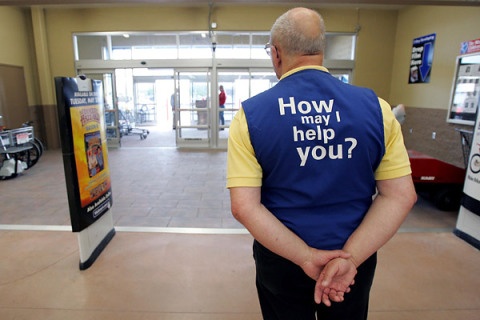Buy in-store, ship to door. It’s not necessarily a new concept. High-ticket electronics, furniture, and carpet stores have been doing home delivery for decades. Groceries and CPG are newer additions. But Walmart has taken on a new spin. In-store shoppers who don’t shop online make up the massive consumer segment that’s eluded digital strategists for years. How to get them to shop online? How to get more of the retail share? After all, of total retail sales dollars, in-store still represents about 90% of the share.
The reasons these shoppers haven’t made the digital leap are many. For one, some are aged and aren’t familiar with online shopping. Others simply prefer to shop in-store. More still, are what Business Insider calls “unbanked.” Business Insider explains, “A large part of the US population [about 15.6 million] is considered unbanked, meaning they have neither a checking account, a savings account, nor a credit card.” Obviously, having no electronic means of payment makes shopping online difficult or impossible. And yet, Walmart has figured out a way to capture these consumers: in-store online shopping.
In-store Walmart employees are equipped with touchscreen devices. Using an app, they can help consumers locate and place an order for any online Walmart item they sell and ship. Whether the item ships to home or ships to store for pickup is determined by the consumer.
Then, the shopper immediately receives a barcode either printed by the associate or sent by email or text. Once presented to the cashier and scanned at checkout, the shopper can pay for the online item with all their other purchases, allowing for cash payment as an option.
In and of itself, bridging traditionally in-store consumers to the never-ending digital shelf is transformative. And, the service could have stopped there as a way to make sales on products either sold out, or not carried in-store. In fact, Target has a similar service, but theirs requires consumers to have a credit card linked to their account.
Walmart has no such requirement. Allowing consumers to pay with cash at checkout for online items gives brands new access to this huge segment of traditional or low-income shoppers.
Along with this opportunity comes a perk and an obligation. The perk is accessibility. Your brand can acquire consumers not previously reached or consumers who would have simply bypassed the sale because the item was not available on the physical shelf.
The obligation is to provide retailers with the best omnichannel content possible, including easy-to-search names, clear product details, updated inventory, and varied, reliable fulfillment options.
Written by: Salsify
Salsify helps thousands of brand manufacturers, distributors, and retailers in over 140 countries collaborate to win on the digital shelf.
Recent Posts
Why Advent Calendar Marketing Is One of the Hottest Holiday Shopping Trends
How To Build a Successful Zero-Party Data Strategy for Ecommerce Personalization
How Social Commerce Is Shaping the Shopping Habits of Every Generation — From Gen Z to Baby Boomers
Subscribe to the Below the Fold Newsletter
Standing out on the digital shelf starts with access to the latest industry content. Subscribe to Below the Fold, our monthly content newsletter, and join other commerce leaders.




.svg)